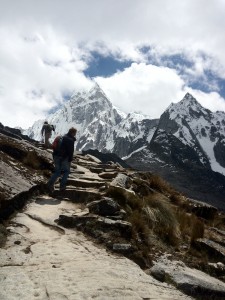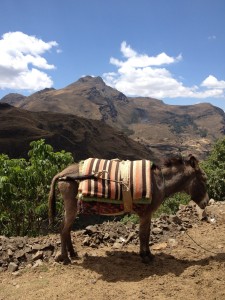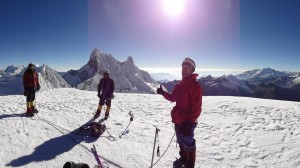Vagablogging Field Reports: chasing altitude in the Cordillera Blanca, Peru
Cost: $20 a day
What’s the strangest thing you’ve seen recently?
In and around Huaraz it’s common to see elderly Quechua woman ambling along paths, bent backed, hauling heavy loads in carrying cloths called K’eperina. Garbed in colourful attire, bowler hats perched upon their heads, they doggedly trek along steep, high altitude slopes that would have fit twenty-somethings huffing and puffing. One of these woman I remember particularly well, because she looked positively ancient. She hopped into a colectivo van I was taking into Huaraz, plopped her K’eperina down and took a seat. She was a tiny desiccated figure, with dark leathery skin and an expressive face full of crevices like the surrounding glacier ridden landscape. When she croaked in the local Quechua dialect she revealed a few crooked, yellowed and lonely teeth. Despite the heat she was heavily bundled in traditional attire and I couldn’t help but make the ghastly comparison with one of the wrapped Incan mummies I had seen recently in a museum in Lima. But alive she was, and after she got out of the the van she hoisted her goods over her shoulders and started shuffling determinedly onward to her destination.
Describe a typical day
My main goal in coming to Huaraz was to introduce myself to mountaineering in a comfortable, inexpensive, yet beautiful part of the world. The city is in close proximity to the Cordillera Blanca, which contains numerous ‘easy’ peaks over 5500 meters. Acclimatisation is crucial so after relaxing for a day in Huaraz I joined a group and started traipsing along the popular Santa Cruz trail. We passed tiny Quechuan villages, impossibly turquoise glacial lakes and burro (donkey) trains as we walked along trails surrounded by immense spires clothed in pure white glaciers. Back in Huaraz I spent my time heading to different mountaineering guide agencies and bargaining for a good price, whilst trying to figure out if I trusted the guide with my life. I have quite a high opinion of living, so I did not choose lightly.
Describe an interesting conversation you’ve had with a local
During a mountaineering trip to Mount Pisco I got to know Juan, the lead guide, a little. He’s 33 years old and has a 4 year old son with a woman who he is now separated from. The previous year he had moved away from Huaraz and worked in the Peruvian Amazon for a logging company in order to earn more money. I was disappointed to hear that he makes more money as part of an enterprise that destroys the environment rather than one that serves to admire it. Despite the financial advantages the call of Juan’s mountainous home was too strong and he returned to guiding after one logging season. With a child to support times can be tough and he may have to return to the jungle, however for now he has chosen to do something he loves. Of course Juan is one of the lucky few who have a choice in this part of the world. Many Quechua live in crippling poverty and must do what ever they can to survive.
What do you like about where you are? Dislike?
I achieved my goal of climbing an Andean mountain. Mount Pisco’s reaches 5750 metres and its summit provides appropriately spectacular views. It’s an easy five thousander, in that it’s essentially a long, steep, high altitude walk with crampons. For most the journey is between 10 to 12 hours to the summit and back down to base camp. My two English companions Luke and James, and our two guides Juan and Pepe started walking at 12.30 am. With no light pollution to speak of stars littered the sky, providing a dim light that made ominous shadows out of the Cordilleras towering peaks. After several hours the sun began to rise bringing out subtle blue and orange hues and turning the dark figures into stunning, white, natural edifices.
It was tough going at times, particularly for the English lads, who weren’t as accustomed to altitude as myself. Luke had a splitting headache and was almost constantly out of breath as we climbed higher. He remarked in anguish several times that ‘it was sooooo steep’. Yep, its a mountain mate, I thought, but I bit my tongue. Despite his obvious discomfort it was inspiring to see him push on.
Upon reaching the summit a grand vista was revealed. The physical toll, sense of achievement and impossibly picturesque terrain affected me deeply. I thrust my ice axe to the heavens and single tear rolled down my cheek…..not really….but I was elated. It was a special moment.
My one complaint with the Cordillera Blanca is the filthy campsites. At times I was forced to engage in a dangerous game of tippy toe, to avoid the sea of local shit (animal and human) waiting to be stepped on. As for Huaraz city itself, it isn’t as remotely attractive as its lofty surrounds. That’s not to say it’s a horrible place, but upon returning from the mountains I felt a strong urge to escape the noisy human centric world and return to the wilderness. The city has some quality eating digs and the locals are extremely amiable, however like any city it has it’s fair share of problems. Stray dogs, many in poor health, roam the streets, obnoxious taxi drivers honk their horns constantly and it’s not uncommon to see deformed beggars sitting on sidewalks with palms upturned.
Describe a challenge you faced
It was difficult for me not to become jaded after spending some time in Huaraz after coming off my mountain high. I kept having to remind myself that most people are doing the best they can and although cities can be truly revolting, beauty exists in the people that inhabit concrete edifices too.
What new lesson did you learn?
It’s essential to learn from experienced guides and wilderness experts to go into the wild successfully. Despite Pisco being and ‘easy’ Andean peak there is no way I would’ve made it to the top of Pisco without the Quechuan guides. Now that I’ve had a taste of an icy world that I can only ever be a visitor to, I find myself wanting more. I’ll visit again.
Where to next?
The Galapagos Islands
You can follow me on Twitter @ash_jordan and Instagram @ashgjordan




November 5th, 2012 at 9:57 am
It seems like it’s ideal to do mountaineering or hiking Cordillera Blanca. Do you have some pictures of your trip there? I would like to join a group or get tour guides for such trip.
November 9th, 2012 at 3:33 pm
Hey Steve
The pics went up a little late as I was having technical difficulties in the Bolivian jungle. The Cordillera Blanca is perfect in many ways for mountaineering and treking- weather, expense, ease of access, beautiful terrain. There are plenty of guiding agencies so it´s never a problem setting something up.